IT Networking Design Report: Comparing UTP, Coaxial, and Fiber Optics
VerifiedAdded on 2023/06/14
|7
|1335
|488
Report
AI Summary
This report provides a detailed comparison of unshielded twisted pair (UTP), coaxial, and single-mode fiber optic cables used in IT networking. It examines each cable type's cost, installation, bandwidth, transmission distance, and endpoint devices. The report highlights the advantages and disadvantages of each, including UTP's speed and cost-effectiveness but vulnerability to interference, coaxial cable's lower price and resilience to interference, and single-mode fiber's high-speed data transmission and resistance to electromagnetic noises. A comparative table summarizes the speed, bandwidth, distance, efficiency, composition, and noise immunity of each cable type. This analysis helps in making informed decisions when selecting the appropriate cabling solution for different networking needs. Desklib offers a wide range of solved assignments and study resources for students.

Running head: IT NETWORKING DESIGN
IT NETWORKING DESIGN
Name of Student
Name of University
Author Note
IT NETWORKING DESIGN
Name of Student
Name of University
Author Note
Paraphrase This Document
Need a fresh take? Get an instant paraphrase of this document with our AI Paraphraser
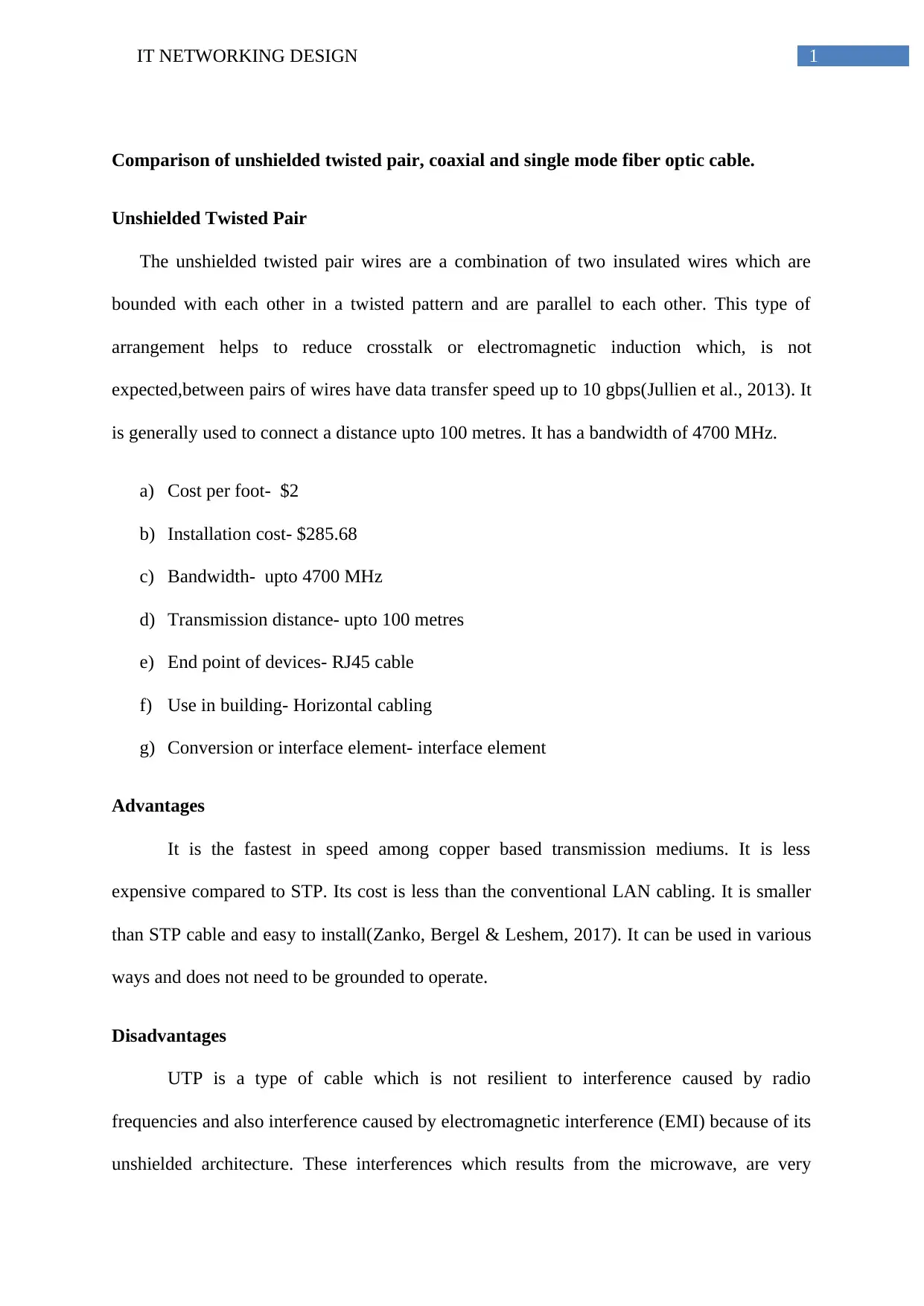
1IT NETWORKING DESIGN
Comparison of unshielded twisted pair, coaxial and single mode fiber optic cable.
Unshielded Twisted Pair
The unshielded twisted pair wires are a combination of two insulated wires which are
bounded with each other in a twisted pattern and are parallel to each other. This type of
arrangement helps to reduce crosstalk or electromagnetic induction which, is not
expected,between pairs of wires have data transfer speed up to 10 gbps(Jullien et al., 2013). It
is generally used to connect a distance upto 100 metres. It has a bandwidth of 4700 MHz.
a) Cost per foot- $2
b) Installation cost- $285.68
c) Bandwidth- upto 4700 MHz
d) Transmission distance- upto 100 metres
e) End point of devices- RJ45 cable
f) Use in building- Horizontal cabling
g) Conversion or interface element- interface element
Advantages
It is the fastest in speed among copper based transmission mediums. It is less
expensive compared to STP. Its cost is less than the conventional LAN cabling. It is smaller
than STP cable and easy to install(Zanko, Bergel & Leshem, 2017). It can be used in various
ways and does not need to be grounded to operate.
Disadvantages
UTP is a type of cable which is not resilient to interference caused by radio
frequencies and also interference caused by electromagnetic interference (EMI) because of its
unshielded architecture. These interferences which results from the microwave, are very
Comparison of unshielded twisted pair, coaxial and single mode fiber optic cable.
Unshielded Twisted Pair
The unshielded twisted pair wires are a combination of two insulated wires which are
bounded with each other in a twisted pattern and are parallel to each other. This type of
arrangement helps to reduce crosstalk or electromagnetic induction which, is not
expected,between pairs of wires have data transfer speed up to 10 gbps(Jullien et al., 2013). It
is generally used to connect a distance upto 100 metres. It has a bandwidth of 4700 MHz.
a) Cost per foot- $2
b) Installation cost- $285.68
c) Bandwidth- upto 4700 MHz
d) Transmission distance- upto 100 metres
e) End point of devices- RJ45 cable
f) Use in building- Horizontal cabling
g) Conversion or interface element- interface element
Advantages
It is the fastest in speed among copper based transmission mediums. It is less
expensive compared to STP. Its cost is less than the conventional LAN cabling. It is smaller
than STP cable and easy to install(Zanko, Bergel & Leshem, 2017). It can be used in various
ways and does not need to be grounded to operate.
Disadvantages
UTP is a type of cable which is not resilient to interference caused by radio
frequencies and also interference caused by electromagnetic interference (EMI) because of its
unshielded architecture. These interferences which results from the microwave, are very
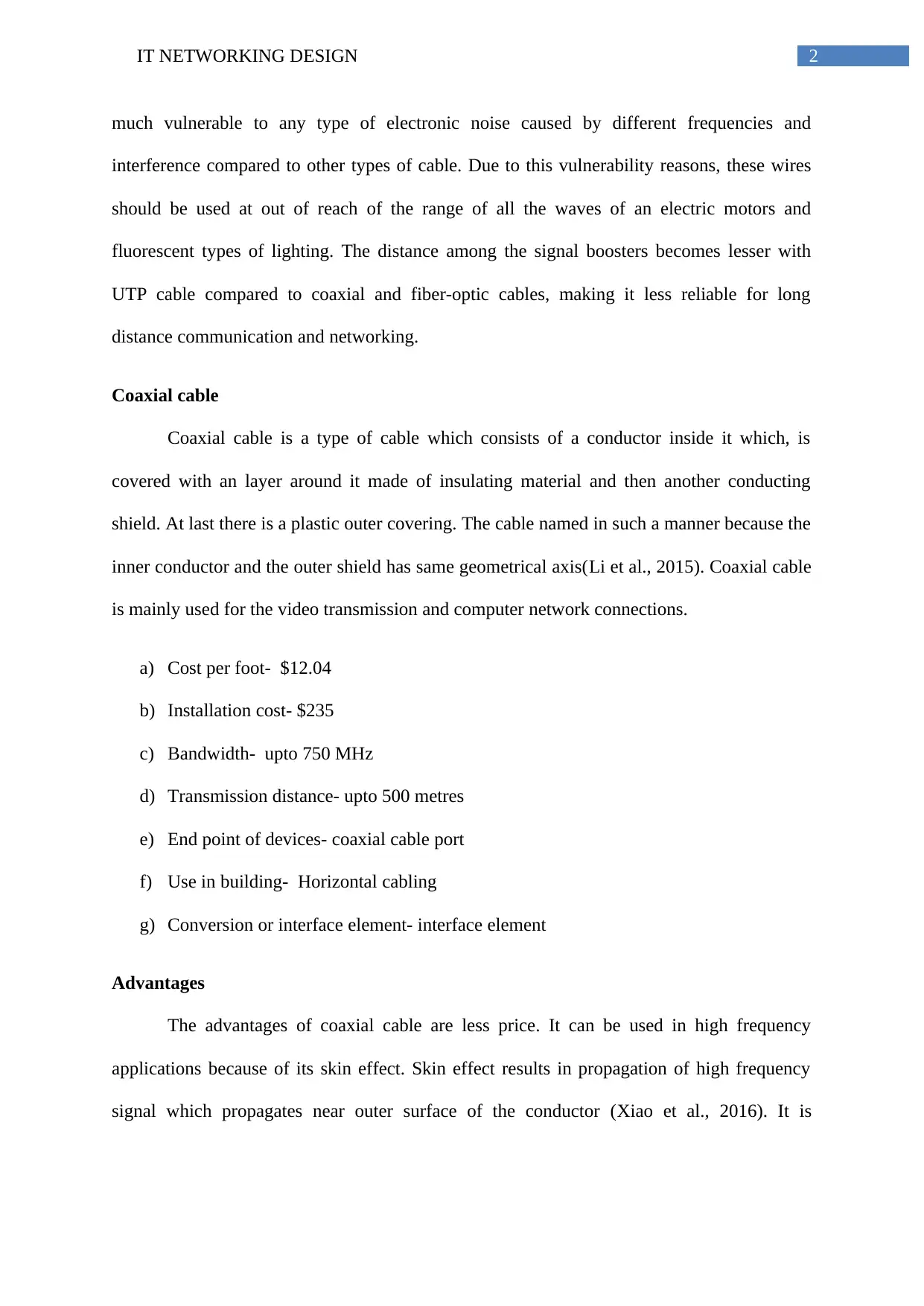
2IT NETWORKING DESIGN
much vulnerable to any type of electronic noise caused by different frequencies and
interference compared to other types of cable. Due to this vulnerability reasons, these wires
should be used at out of reach of the range of all the waves of an electric motors and
fluorescent types of lighting. The distance among the signal boosters becomes lesser with
UTP cable compared to coaxial and fiber-optic cables, making it less reliable for long
distance communication and networking.
Coaxial cable
Coaxial cable is a type of cable which consists of a conductor inside it which, is
covered with an layer around it made of insulating material and then another conducting
shield. At last there is a plastic outer covering. The cable named in such a manner because the
inner conductor and the outer shield has same geometrical axis(Li et al., 2015). Coaxial cable
is mainly used for the video transmission and computer network connections.
a) Cost per foot- $12.04
b) Installation cost- $235
c) Bandwidth- upto 750 MHz
d) Transmission distance- upto 500 metres
e) End point of devices- coaxial cable port
f) Use in building- Horizontal cabling
g) Conversion or interface element- interface element
Advantages
The advantages of coaxial cable are less price. It can be used in high frequency
applications because of its skin effect. Skin effect results in propagation of high frequency
signal which propagates near outer surface of the conductor (Xiao et al., 2016). It is
much vulnerable to any type of electronic noise caused by different frequencies and
interference compared to other types of cable. Due to this vulnerability reasons, these wires
should be used at out of reach of the range of all the waves of an electric motors and
fluorescent types of lighting. The distance among the signal boosters becomes lesser with
UTP cable compared to coaxial and fiber-optic cables, making it less reliable for long
distance communication and networking.
Coaxial cable
Coaxial cable is a type of cable which consists of a conductor inside it which, is
covered with an layer around it made of insulating material and then another conducting
shield. At last there is a plastic outer covering. The cable named in such a manner because the
inner conductor and the outer shield has same geometrical axis(Li et al., 2015). Coaxial cable
is mainly used for the video transmission and computer network connections.
a) Cost per foot- $12.04
b) Installation cost- $235
c) Bandwidth- upto 750 MHz
d) Transmission distance- upto 500 metres
e) End point of devices- coaxial cable port
f) Use in building- Horizontal cabling
g) Conversion or interface element- interface element
Advantages
The advantages of coaxial cable are less price. It can be used in high frequency
applications because of its skin effect. Skin effect results in propagation of high frequency
signal which propagates near outer surface of the conductor (Xiao et al., 2016). It is
⊘ This is a preview!⊘
Do you want full access?
Subscribe today to unlock all pages.

Trusted by 1+ million students worldwide
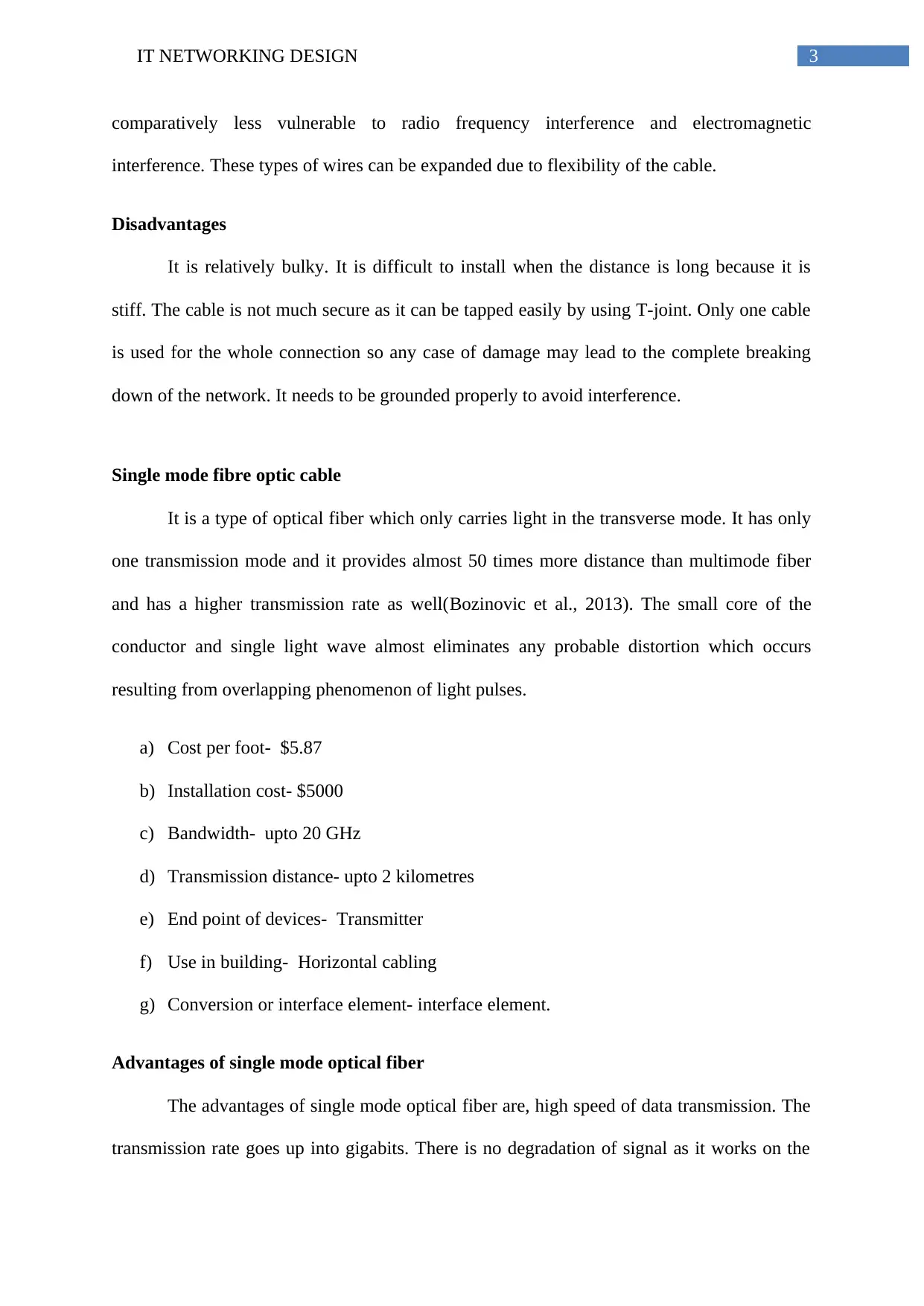
3IT NETWORKING DESIGN
comparatively less vulnerable to radio frequency interference and electromagnetic
interference. These types of wires can be expanded due to flexibility of the cable.
Disadvantages
It is relatively bulky. It is difficult to install when the distance is long because it is
stiff. The cable is not much secure as it can be tapped easily by using T-joint. Only one cable
is used for the whole connection so any case of damage may lead to the complete breaking
down of the network. It needs to be grounded properly to avoid interference.
Single mode fibre optic cable
It is a type of optical fiber which only carries light in the transverse mode. It has only
one transmission mode and it provides almost 50 times more distance than multimode fiber
and has a higher transmission rate as well(Bozinovic et al., 2013). The small core of the
conductor and single light wave almost eliminates any probable distortion which occurs
resulting from overlapping phenomenon of light pulses.
a) Cost per foot- $5.87
b) Installation cost- $5000
c) Bandwidth- upto 20 GHz
d) Transmission distance- upto 2 kilometres
e) End point of devices- Transmitter
f) Use in building- Horizontal cabling
g) Conversion or interface element- interface element.
Advantages of single mode optical fiber
The advantages of single mode optical fiber are, high speed of data transmission. The
transmission rate goes up into gigabits. There is no degradation of signal as it works on the
comparatively less vulnerable to radio frequency interference and electromagnetic
interference. These types of wires can be expanded due to flexibility of the cable.
Disadvantages
It is relatively bulky. It is difficult to install when the distance is long because it is
stiff. The cable is not much secure as it can be tapped easily by using T-joint. Only one cable
is used for the whole connection so any case of damage may lead to the complete breaking
down of the network. It needs to be grounded properly to avoid interference.
Single mode fibre optic cable
It is a type of optical fiber which only carries light in the transverse mode. It has only
one transmission mode and it provides almost 50 times more distance than multimode fiber
and has a higher transmission rate as well(Bozinovic et al., 2013). The small core of the
conductor and single light wave almost eliminates any probable distortion which occurs
resulting from overlapping phenomenon of light pulses.
a) Cost per foot- $5.87
b) Installation cost- $5000
c) Bandwidth- upto 20 GHz
d) Transmission distance- upto 2 kilometres
e) End point of devices- Transmitter
f) Use in building- Horizontal cabling
g) Conversion or interface element- interface element.
Advantages of single mode optical fiber
The advantages of single mode optical fiber are, high speed of data transmission. The
transmission rate goes up into gigabits. There is no degradation of signal as it works on the
Paraphrase This Document
Need a fresh take? Get an instant paraphrase of this document with our AI Paraphraser
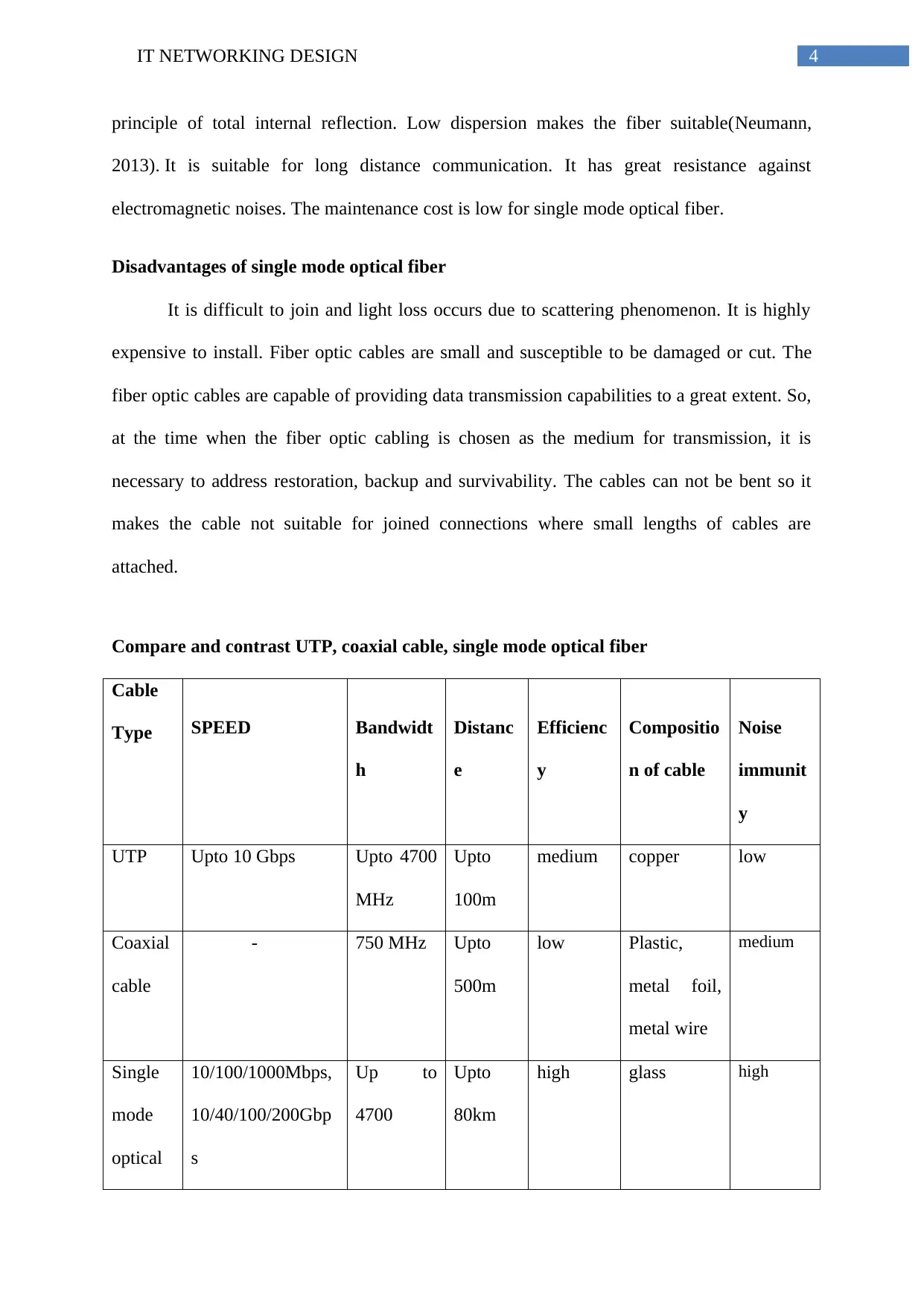
4IT NETWORKING DESIGN
principle of total internal reflection. Low dispersion makes the fiber suitable(Neumann,
2013). It is suitable for long distance communication. It has great resistance against
electromagnetic noises. The maintenance cost is low for single mode optical fiber.
Disadvantages of single mode optical fiber
It is difficult to join and light loss occurs due to scattering phenomenon. It is highly
expensive to install. Fiber optic cables are small and susceptible to be damaged or cut. The
fiber optic cables are capable of providing data transmission capabilities to a great extent. So,
at the time when the fiber optic cabling is chosen as the medium for transmission, it is
necessary to address restoration, backup and survivability. The cables can not be bent so it
makes the cable not suitable for joined connections where small lengths of cables are
attached.
Compare and contrast UTP, coaxial cable, single mode optical fiber
Cable
Type SPEED Bandwidt
h
Distanc
e
Efficienc
y
Compositio
n of cable
Noise
immunit
y
UTP Upto 10 Gbps Upto 4700
MHz
Upto
100m
medium copper low
Coaxial
cable
- 750 MHz Upto
500m
low Plastic,
metal foil,
metal wire
medium
Single
mode
optical
10/100/1000Mbps,
10/40/100/200Gbp
s
Up to
4700
Upto
80km
high glass high
principle of total internal reflection. Low dispersion makes the fiber suitable(Neumann,
2013). It is suitable for long distance communication. It has great resistance against
electromagnetic noises. The maintenance cost is low for single mode optical fiber.
Disadvantages of single mode optical fiber
It is difficult to join and light loss occurs due to scattering phenomenon. It is highly
expensive to install. Fiber optic cables are small and susceptible to be damaged or cut. The
fiber optic cables are capable of providing data transmission capabilities to a great extent. So,
at the time when the fiber optic cabling is chosen as the medium for transmission, it is
necessary to address restoration, backup and survivability. The cables can not be bent so it
makes the cable not suitable for joined connections where small lengths of cables are
attached.
Compare and contrast UTP, coaxial cable, single mode optical fiber
Cable
Type SPEED Bandwidt
h
Distanc
e
Efficienc
y
Compositio
n of cable
Noise
immunit
y
UTP Upto 10 Gbps Upto 4700
MHz
Upto
100m
medium copper low
Coaxial
cable
- 750 MHz Upto
500m
low Plastic,
metal foil,
metal wire
medium
Single
mode
optical
10/100/1000Mbps,
10/40/100/200Gbp
s
Up to
4700
Upto
80km
high glass high

5IT NETWORKING DESIGN
fiber
fiber
⊘ This is a preview!⊘
Do you want full access?
Subscribe today to unlock all pages.

Trusted by 1+ million students worldwide
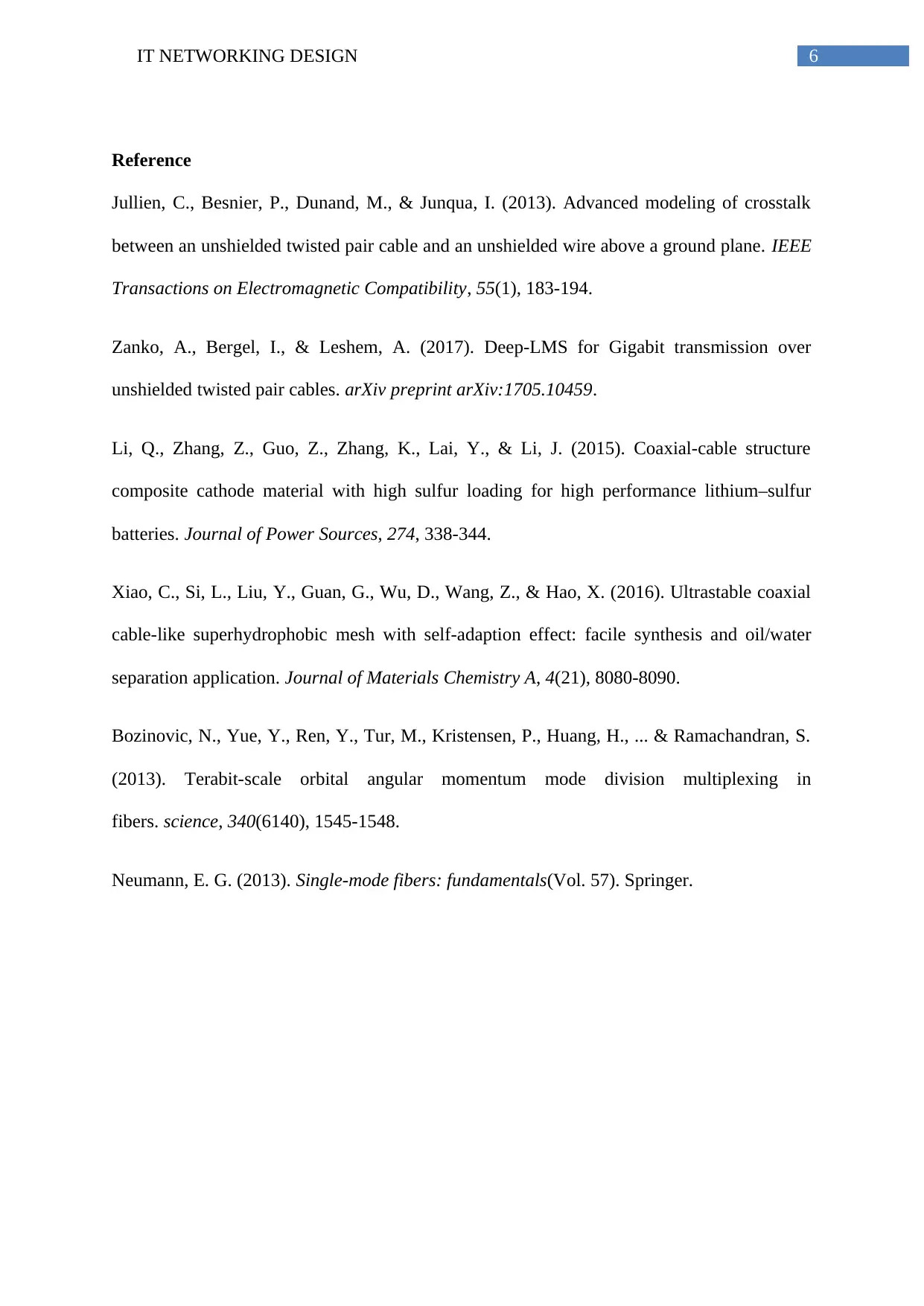
6IT NETWORKING DESIGN
Reference
Jullien, C., Besnier, P., Dunand, M., & Junqua, I. (2013). Advanced modeling of crosstalk
between an unshielded twisted pair cable and an unshielded wire above a ground plane. IEEE
Transactions on Electromagnetic Compatibility, 55(1), 183-194.
Zanko, A., Bergel, I., & Leshem, A. (2017). Deep-LMS for Gigabit transmission over
unshielded twisted pair cables. arXiv preprint arXiv:1705.10459.
Li, Q., Zhang, Z., Guo, Z., Zhang, K., Lai, Y., & Li, J. (2015). Coaxial-cable structure
composite cathode material with high sulfur loading for high performance lithium–sulfur
batteries. Journal of Power Sources, 274, 338-344.
Xiao, C., Si, L., Liu, Y., Guan, G., Wu, D., Wang, Z., & Hao, X. (2016). Ultrastable coaxial
cable-like superhydrophobic mesh with self-adaption effect: facile synthesis and oil/water
separation application. Journal of Materials Chemistry A, 4(21), 8080-8090.
Bozinovic, N., Yue, Y., Ren, Y., Tur, M., Kristensen, P., Huang, H., ... & Ramachandran, S.
(2013). Terabit-scale orbital angular momentum mode division multiplexing in
fibers. science, 340(6140), 1545-1548.
Neumann, E. G. (2013). Single-mode fibers: fundamentals(Vol. 57). Springer.
Reference
Jullien, C., Besnier, P., Dunand, M., & Junqua, I. (2013). Advanced modeling of crosstalk
between an unshielded twisted pair cable and an unshielded wire above a ground plane. IEEE
Transactions on Electromagnetic Compatibility, 55(1), 183-194.
Zanko, A., Bergel, I., & Leshem, A. (2017). Deep-LMS for Gigabit transmission over
unshielded twisted pair cables. arXiv preprint arXiv:1705.10459.
Li, Q., Zhang, Z., Guo, Z., Zhang, K., Lai, Y., & Li, J. (2015). Coaxial-cable structure
composite cathode material with high sulfur loading for high performance lithium–sulfur
batteries. Journal of Power Sources, 274, 338-344.
Xiao, C., Si, L., Liu, Y., Guan, G., Wu, D., Wang, Z., & Hao, X. (2016). Ultrastable coaxial
cable-like superhydrophobic mesh with self-adaption effect: facile synthesis and oil/water
separation application. Journal of Materials Chemistry A, 4(21), 8080-8090.
Bozinovic, N., Yue, Y., Ren, Y., Tur, M., Kristensen, P., Huang, H., ... & Ramachandran, S.
(2013). Terabit-scale orbital angular momentum mode division multiplexing in
fibers. science, 340(6140), 1545-1548.
Neumann, E. G. (2013). Single-mode fibers: fundamentals(Vol. 57). Springer.
1 out of 7
Related Documents
Your All-in-One AI-Powered Toolkit for Academic Success.
+13062052269
info@desklib.com
Available 24*7 on WhatsApp / Email
![[object Object]](/_next/static/media/star-bottom.7253800d.svg)
Unlock your academic potential
Copyright © 2020–2025 A2Z Services. All Rights Reserved. Developed and managed by ZUCOL.




